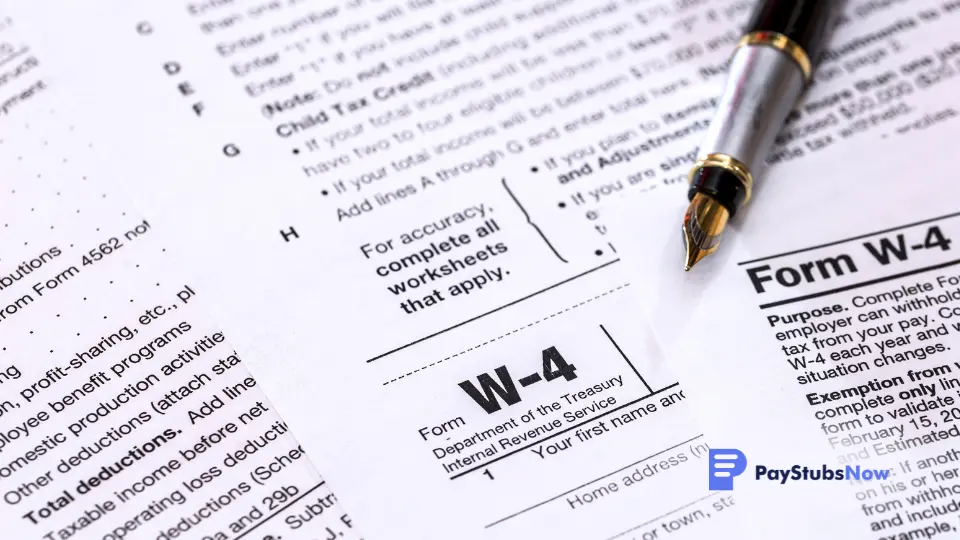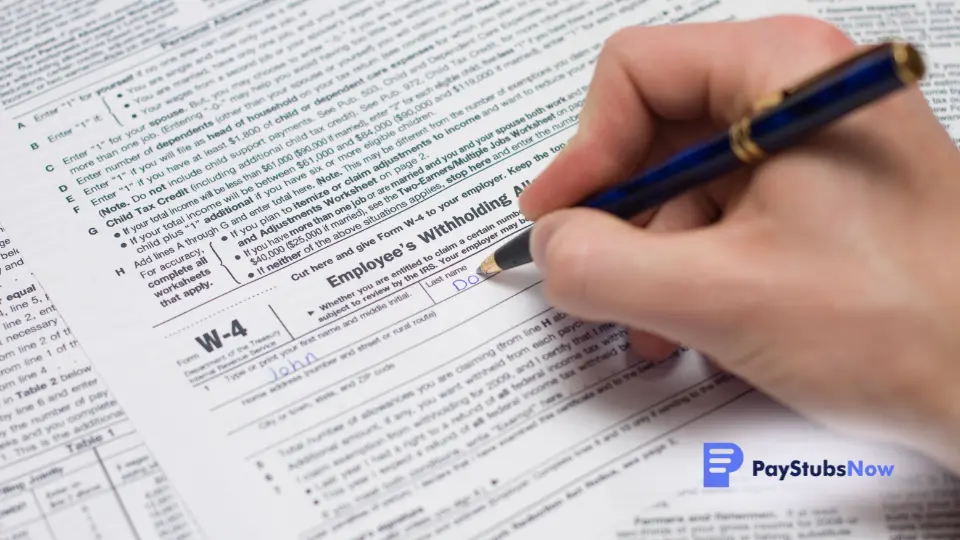What Is a W-4? Understanding Your Tax Withholding Form
As an employer, you shoulder the responsibility of making accurate tax deductions based on the information that your employees provide in their W-4 forms. This critical piece of documentation dictates the amount of federal income tax to withhold from their paychecks.
This blog post will give you an in-depth understanding of the W-4 form. We'll guide you on how to ensure your employees fill it out correctly and avoid common pitfalls. Further, we'll explore how Paystubsnow, a digital tool that generates crucial pay-related documents, can facilitate your tax management.
Key Highlights of Form W-4
- The W-4 form is a crucial document used by employees to indicate their tax situation to their employer, determining how much federal income tax is withheld from their paycheck.
- Understanding how to properly fill and submit a W-4 form, including being aware of common mistakes and the latest updates, can ensure compliance and accurate tax withholding.
- It is recommended that individuals adjust their W-4 form if they experience significant life changes, such as marriage or having a child.
- Paystubsnow can facilitate the easy and accurate creation of pay-related forms, aiding in the management and compliance of essential tax documentation.
- The correct completion and management of W-4 forms are crucial as they affect how much income tax is withheld, impacting potential tax refunds or owed money at the end of the tax year.
Overview of the W-4 Form

The W-4 form, officially called the Employee's Withholding Certificate, is a document used by the Internal Revenue Service (IRS) to determine how much federal income tax should be withheld from an employee's paycheck throughout the year.
The Purpose of the W-4 Form
The W-4 essentially acts as a communication bridge between you and your employee regarding their tax situation. When an employee starts a new job or their circumstances change, they are required to complete a W-4 to provide details about their marital status, dependents, and other factors that influence their tax liability.
Based on this information, you, as an employer, can then calculate the appropriate amount of federal income tax to withhold from the employee’s paycheck. This ensures a smoother tax filing process later in the year.
Its Impact on Paychecks and Tax Returns
The W-4 essentially helps an employee avoid tax surprises come April 15th. Here's how it affects their financial picture:
- Accurate Withholding: A well-filled W-4 ensures the correct amount of tax is withheld throughout the year. This translates to a smaller refund (An employee wasn't essentially giving the government an interest-free loan) or a smaller tax bill (The employee wasn't underpaying throughout the year).
- Over Withholding: If the W-4 instructs you to withhold too much tax, your employee will receive a larger refund when they file their tax return. This might seem beneficial, but it means they have lost access to that money throughout the year.
- Under Withholding: If the W-4 indicates too little tax should be withheld, your employee might owe money when they file their tax return, potentially incurring penalties.
Who Needs to Fill out A W-4 Form?

Anyone working for a U.S. employer, regardless of employment status, needs to fill out a W-4 form. This includes:
- Full-time employees: This is the most common scenario. If an employee works a standard 40-hour week or more, they'll need to submit a W-4.
- Part-time employees: Even if employees work a limited number of hours each week, they're still responsible for federal income taxes. Filling out a W-4 ensures the appropriate amount is withheld from their paycheck.
- Contract workers: If an employee works on a contract basis for a company, they'll also need to complete a W-4.
- Temporary workers: Temporary positions often involve shorter assignments, but a temporary worker still needs to submit a W-4 to ensure proper tax withholding.
Essentially, if someone is receiving a paycheck from a U.S. employer, they'll need to complete a W-4 form. This ensures the government receives its fair share of taxes throughout the year and helps the person avoid any surprises or penalties come tax season.
Where To Find Form W-4
For employers looking to guide their employees on how to obtain a Form W-4, there are two primary avenues:
- Directly from the IRS Website: The Internal Revenue Service (IRS) website offers the latest version of the W-4 form for download. It can be accessed directly at https://www.irs.gov/forms-pubs/about-form-w-4.
- Through the Employer: Typically, employers provide the W-4 form as part of the onboarding process. This can be included in the new hire paperwork packet or made available electronically through the company's internal portal or HR management system.
Employers should emphasize the availability of these options and may prefer to directly provide the form to streamline the process and ensure compliance.
Choosing Between the Two
When deciding where to obtain a Form W-4, employees often have two scenarios to consider:
- Starting a New Job: If an employee has recently been hired and has not yet received a W-4 form from their new employer, they can proactively download the latest version directly from the IRS website. This ensures that they are filling out the most up-to-date form right from the start, helping to avoid any complications with tax withholdings.
- Updating Your W-4: For employees who experience changes in their tax situation (such as marriage, the birth of a child, or a change in financial status), it's advisable to update their W-4 form to reflect these changes. Downloading the newest version from the IRS website guarantees they are using the form that accounts for the latest tax laws and regulations.
It’s crucial for employers to remind their employees of the importance of using the most recent version of the W-4, regardless of whether they obtain it directly from the IRS or through the company’s provided resources. This ensures accuracy in tax withholdings and compliance with the IRS regulations, benefiting the employer and the employee.
How To Fill Out a W-4 Form

The W-4 form can seem confusing to an employee at first glance, but if you help them with resources to understand each section, they can complete it accurately and on time. Here's a breakdown of the information an employee needs to provide on this tax form:
Step 1: Personal Information (Lines 1-5)
This section is a straightforward introduction, asking for an employee's basic details:
- Full Name (Line 1): The employee will need to enter their legal first and last name exactly as it appears on their Social Security card.
- Address (Lines 2 & 3): Here, they will provide their current mailing address where they will receive tax-related correspondence.
- Social Security Number (Line 4): They enter their Social Security number without any hyphens or spaces here.
- Daytime Phone Number (Line 5): The employee includes their phone number where the employer can reach them if necessary (optional).
Step 2: Filing Status (Line 6)
An employee's filing status significantly impacts their tax liability as it determines the tax brackets they fall under. Therefore, they should choose the option that best reflects their current marital situation:
- Single: This applies if they're unmarried or legally separated.
- Married Filing Jointly: This is typically the most advantageous option for married couples filing together.
- Married Filing Separately: This option is less common and might be chosen in specific tax situations. Consult a tax professional for guidance.
- Head of Household: This applies to unmarried individuals with qualifying dependents who are living with them for at least half the year.
- Qualifying Widow(er) With Dependent Child: This applies to widowed individuals who haven't remarried and have a qualifying dependent child.
Step 3: Multiple Jobs or Spouse's Wages (Line 7)
This box needs to be checked if they hold multiple jobs simultaneously or if their spouse also works and earns income. This helps ensure you can withhold enough tax to avoid underpayment throughout the year. The W-4 includes a worksheet (on page 3) to help employees calculate the appropriate adjustments if both spouses work.
Step 4: Claiming Dependents (Lines 8a & 8b)
This section allows an employee to claim allowances based on their qualifying dependents. Each dependent claimed reduces the amount of federal income tax withheld from their paycheck. Here's what they'll need:
- Number of Qualifying Children (Line 8a): The employee needs to enter the number of children who qualify as their dependents according to the IRS definition.
- Other Dependents (Line 8b): If they have dependents other than children (e.g., elderly parents), they should enter the total number here. The IRS guidelines must be reviewed to ensure they qualify as dependents.
Important Note: Claiming dependents the employee isn't eligible for can lead to penalties when they file their tax return. Make sure they understand the IRS definition of a dependent before claiming anyone.
Step 5 (Optional): Other Adjustments (Lines 9 & 10)
This section is a bit more complex and may not apply to everyone. It allows employees to claim additional allowances or deductions if their tax situation requires it. For example, they might be eligible for adjustments if:
- They anticipate claiming itemized deductions on their tax return that exceed the standard deduction.
- They have significant income from sources other than their paycheck, such as self-employment income. Adjustments might be needed to avoid overpayment.
Important Note: This section can be intricate. If your tax situation is complex or you're unsure about claiming additional allowances or deductions, consult with a tax professional.
Step 6: Sign and Date (Line 11 & 12)
Once they've completed all applicable sections, they must carefully review all information for accuracy. Typos or errors can lead to underpayment or overpayment of taxes, so double-checking for these before they finally sign and date the form on Lines 11 and 12 is essential.
By following these steps and providing truthful information, your employees can ensure their W-4 forms accurately reflect their tax situation and help them avoid any surprises come tax season.
How To Adjust Your W-4

Life throws curveballs, and the tax situation is no exception. The good news is the W-4 isn't a one-time deal! Employees can submit a new W-4 to their employers at any point to reflect any changes in their tax situation and ensure their tax withholding remains accurate.
Here are some scenarios that might prompt a W-4 adjustment:
- Marital Status Changes: Changes such as getting married, divorced, or becoming a widow(er) can significantly impact an employee's filing status and tax liability.
- Family Changes: Having a child, adopting a dependent, or a dependent aging out of dependency status all necessitate adjustments to the W-4.
- Income Fluctuations: If an employee's income significantly increases or decreases (like when starting a side hustle or changing jobs), they should adjust their W-4 to avoid underpayment or overpayment over the year.
- Deduction Changes: If they switch between claiming the standard deduction and itemizing deductions, they might need to adjust your W-4 to reflect this change.
Submitting a New W-4
To adjust their W-4, the employee should simply obtain a new form (they can download it from the IRS website or get it from the employer), fill it out based on their current situation, and submit the completed form to the employer's payroll department. The employer will then use the information on the new W-4 to calculate the employee's tax withholding moving forward.
Remember: It's always best to err on the side of caution. If your employees are unsure whether they need to adjust their W-4, they must consult a tax professional for guidance.
Elevate Your Tax Documentation With Paystubsnow
Now that you're well-versed in the crucial role of W-4 forms for determining an employee's tax withholdings, you understand that these forms directly influence what appears on the annual W-2 forms.
The accuracy of an employee’s W-4 affects how much tax is withheld from each paycheck, which is then reported on the W-2 forms. This makes it essential for employers to ensure that the data from W-4 forms is correctly reflected in the W-2 forms. This is where Paystubsnow comes in.
Here’s why Paystubsnow is the ideal solution for generating accurate W-2 forms:
- Reflect Accurate Withholding: Paystubsnow helps employers generate W-2 forms that accurately reflect the withholding data provided by the employees through their W-4 forms. This ensures that each employee's tax liabilities are correctly reported at the year's end.
- Compliance and Efficiency: With Paystubsnow, you can be sure that your W-2 forms adhere to IRS regulations, helping avoid costly penalties and ensuring compliance.
- Streamlined Process: The platform’s automation features save time and reduce errors, making it easier to manage year-end documentation. You can quickly access and distribute W-2 forms to employees, ensuring they have what they need for their tax filings.
So, generate W2 forms now and confidently manage your tax documents while freeing yourself to focus on what matters most.

